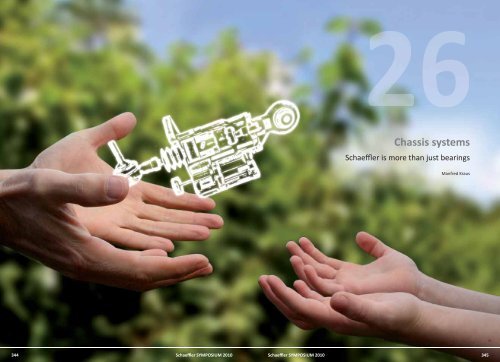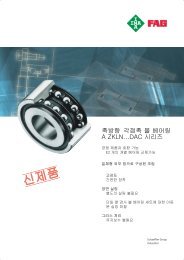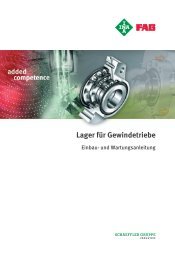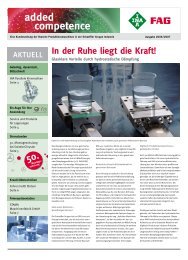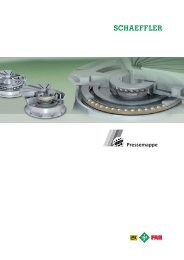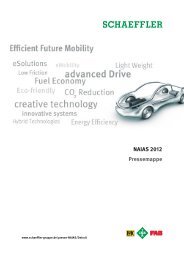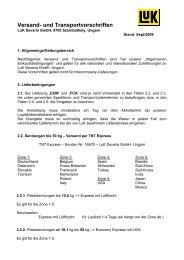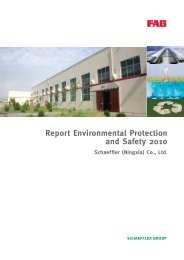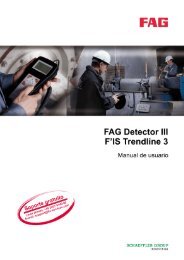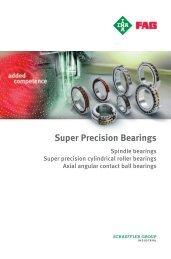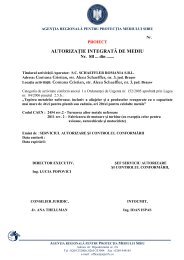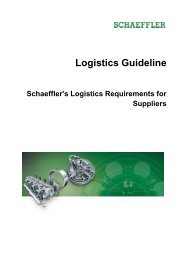26 - Schaeffler Group
26 - Schaeffler Group
26 - Schaeffler Group
Create successful ePaper yourself
Turn your PDF publications into a flip-book with our unique Google optimized e-Paper software.
<strong>26</strong> Chassis<br />
<strong>26</strong> Chassis<br />
344<br />
Schaeffl er SYMPOSIUM 2010<br />
Schaeffl er SYMPOSIUM 2010<br />
345<br />
Chassis<br />
Chassis systems<br />
Schaeffl er is more than just bearings<br />
Manfred Kraus<br />
<strong>26</strong><br />
<strong>26</strong>
<strong>26</strong> Chassis<br />
Introducti on<br />
The launch of ABS in the 1970s marked the<br />
starting point for the introduction of electronic<br />
control systems in chassis. In the following<br />
years, driving dynamics control systems were<br />
used to an increasing extent in passenger cars,<br />
with longitudinal, vertical and lateral dynamic<br />
driving characteristics can be improved. Further<br />
potential resulted from the ever increasing<br />
networking of functions [3]. This further development<br />
of the on-board power supply is currently<br />
setting prerequisites for further driving<br />
dynamics systems with electromechanical actuators.<br />
Some of these systems – such as the superimposed<br />
steering system – owe their existence and<br />
full functionality to increasing, further development<br />
of electromechanical systems and microprocessor<br />
technology. Other systems have hydromechanical<br />
predecessors such as electric<br />
power steering (EPS), rear wheel steering and<br />
torque vectoring (distribution of the driving forces<br />
to the driven axle using an electromechanical<br />
actuator). The expansion of the functions of<br />
these systems, however, was only possible with<br />
further development of microprocessor technology.<br />
For example, the parking assist system of an<br />
EPS with hydraulic steering can only be produced<br />
at significantly higher cost. In addition, the energy<br />
consumption of hydraulic actuators in chassis<br />
is much higher than that of electromechanical<br />
actuators, which only consume energy when<br />
required.<br />
The following objecti ves can be derived for chassis<br />
systems from the above.<br />
The replacement<br />
of hydraulic actuators<br />
The objective is to reduce the power consumption<br />
and improve existing functions, such as in<br />
steering systems. EPS has already achieved high<br />
market penetration here and is established on<br />
the market.<br />
There has been similar development in the case of<br />
hydraulically actuated roll stabilizati on systems<br />
which will soon be replaced by electromechanical<br />
systems. It is possible that hydraulic base point displacement<br />
of the wheel suspension (so-called ac-<br />
ti ve body control ABC) will be replaced by an electromechanical<br />
variant.<br />
Rear axle steering, which was offered on the European<br />
market as a hydraulic variant in the<br />
1980s and 1990s, is currently experiencing a renaissance.<br />
However, the new systems have electromechanical<br />
actuators, are more economical,<br />
have more favorable fuel consumption and are<br />
easier to integrate.<br />
Development<br />
of new functi ons<br />
The superimposed steering system can only be<br />
manufactured on an industrial scale using an<br />
electromechanical actuator. It made it possible<br />
to superimpose the steering angle components<br />
calculated by a driving dynamics controller on<br />
the driver’s steering input, without having to<br />
disconnect the mechanical connection between<br />
the steering wheel and the front wheels, as<br />
would be required by pure, by-wire systems. In<br />
the area of vertical dynamics, a mention must<br />
be made of controlled damper settings, which<br />
not only enable adjustment in accordance with<br />
the loads and driving style, but which also contain<br />
more or less developed “sky-hook” components<br />
in the damper algorithms used.<br />
Linking of systems<br />
The combination of superimposed steering with<br />
ESP enables the frequency and level of stabilizing<br />
braking interventions to be significantly reduced.<br />
The combination of superimposed steering<br />
with rear wheel steering, on the other hand,<br />
results in a significant increase in the cornering<br />
performance at low speeds, while at the same<br />
time increasing the agility and stability in the<br />
medium and high-speed range. Similar lateral<br />
dynamic results must be achieved with the combination<br />
of superimposed steering and torque<br />
vectoring. Traction can be improved with torque<br />
vectoring and is comparable with a controlled<br />
locking differential.<br />
If steering and braking systems are linked with<br />
environment detection systems with GPS and<br />
car-to-car communication, it will open up new<br />
possibilities which could lead to adaptive cruise<br />
control and a lane-keeping assistant and, in future,<br />
collision mitigation and avoidance or even<br />
autonomous driving.<br />
Schaeffl er –<br />
more than a wheel<br />
bearing<br />
<strong>Schaeffler</strong> had already started development of<br />
mechanical actuators (ball screw drive, small<br />
planetary gear and cylindrical gear units and the<br />
bearing support for the entire module) for electromechanical<br />
brakes in the 1990s. Mechanical<br />
modules for EPS were developed based on these<br />
actuators, comprising the ball screw drive including<br />
the toothed rack and bearing supports,<br />
which have been on the market since 2007 and<br />
whose manufacturing quantities continuously<br />
increase.<br />
Automa�c level control<br />
Electric ABC<br />
Electric damper<br />
Development of electromechanical systems was<br />
started based on the mechanical modules and orientated<br />
on the strategic directi on of Schaeffl er. The<br />
focus of development is on new chassis functi ons,<br />
for which there has been no market unti l now. Figure<br />
1 shows an overview of all current chassis development<br />
acti viti es.<br />
The development objectives are to increase the<br />
power density and reduce the power consumption<br />
and costs of the systems, was well as generate<br />
new functions. This will increase the attractiveness<br />
for customers and widen the lead over<br />
the competition. Some chassis system develop-<br />
346 Schaeffl er SYMPOSIUM 2010<br />
Schaeffl er SYMPOSIUM 2010 347<br />
Roll<br />
stabiliza�on<br />
Figure 1 Overview of chassis acti viti es at Schaeffl er<br />
Chassis<br />
ments are described in more detail below as an<br />
example.<br />
Rear axle steering<br />
The earliest rear wheel steering developments<br />
showed to some extent the potenti al in this area<br />
[4], [6]. However, current boundary conditi ons<br />
appear to make a reassessment of rear wheel<br />
steering or acti ve, toe-in actuati on on the rear<br />
axle necessary. “Acti ve rear axle kinemati cs”<br />
(ARK) is a useful term to describe this technology.<br />
There are new boundary conditi ons for actuators<br />
due to the current widespread use of electromechanical<br />
steering assistance on the front axle and,<br />
therefore, the possibil-<br />
Rear wheel steering<br />
Electric Mobility/<br />
wheel drive<br />
ity of economically<br />
transferring this technology<br />
to ARK. In comparison<br />
to a hydromechanical<br />
soluti on, the<br />
actuati on ti me along<br />
with the costs can be<br />
reduced, and the applicati<br />
on limits and performance,<br />
parti cularly<br />
at extreme temperatures,<br />
can be increased.<br />
In additi on, the increasingnetworkability<br />
of chassis systems<br />
and the many state<br />
functi ons available for<br />
driving dynamics contribute<br />
to bett er quality<br />
chassis control [5].<br />
This means that the possibiliti es for driving dynamics<br />
and the potenti al of ARK can be nearly<br />
fully exploited, as demonstrated by vehicles<br />
which have been launched recently with this<br />
technology [2].<br />
Requirements<br />
and benefi ts of ARK<br />
The requirements for an ARK system can be summarized<br />
in a generalized form:<br />
�� Adjustment angle on the wheel: +/- 3.5°<br />
<strong>26</strong><br />
<strong>26</strong>
<strong>26</strong> Chassis<br />
�� Adjustment distance on the actuator = 10 to<br />
25 mm (depending on the axle)<br />
�� Max. actuati on speed up to 100 mm/sec for<br />
50 % of the full stroke<br />
�� Positi oning/resoluti on: < 0.1 mm<br />
�� Actuati on force up to approx. 6 kN, stati c overload<br />
up to 30 kN<br />
�� Higher electromechanical effi ciency (max. batt ery<br />
current < 40 A with a 12 V on-board power supply)<br />
�� Minimal energy consumpti on with a constant<br />
wheel angle<br />
�� Fail-safe behavior by holding the positi on in case<br />
of a defect<br />
The features of the actuator can be adapted to<br />
the specific requirements of the OEM if required.<br />
The following advantages of the system can be fully<br />
used if the named requirements are fulfi lled:<br />
�� Opti mizati on of the ti me profi le of transverse<br />
accelerati on and yaw rate for the vehicle under<br />
transient driving conditi ons<br />
�� More direct response to steering commands<br />
�� Reduced inclinati on to overshoot (rear of the<br />
vehicle breaks away)<br />
�� Increased safety and stability, parti cularly during<br />
braking in curves under μ-split conditi ons<br />
�� Potenti al for improving the directi onal stability<br />
by reducing the structural, kinemati c, toe-in<br />
change of the rear axle<br />
Locking<br />
�� Optimized stability<br />
mechanism<br />
during trailer operation<br />
�� Reduced turning<br />
cycle<br />
�� Reduced ti re wear<br />
and fuel consumpti on<br />
due to the possibility<br />
of reducing the initi al<br />
toe-in<br />
There are many references<br />
to tests available<br />
which quantify<br />
the advantages. The<br />
improved response<br />
behavior and increased stability are, for example,<br />
recorded and measured by means of the<br />
18 m slalom and the ISO lane changing test.<br />
ARK enables higher, drive-through speeds during<br />
these driving maneuvers, as proved in different<br />
tests [1], [9]. These tests can also be<br />
used as an argument for improved trailer operation.<br />
The reduction in the turning circle can be<br />
read from the Ackermann equation by making a<br />
simple adjustment. It can be also be shown that<br />
the stated pivot range of +/- 3.5° of an ARK system<br />
is sufficient to achieve a significant reduction<br />
in the turning circle [1].<br />
Actuator design for ARK<br />
The basic actuator configuration comprises the<br />
components shown such as the electric motor<br />
with the power electronics system, sensor and<br />
ball screw drive as the gearing or mechanical actuation<br />
element.<br />
The gearing is generally designed to be self-locking<br />
so that no retaining forces/currents are required<br />
in a static condition and the actuator<br />
does not change its position when no current is<br />
flowing, as in the case of a possible malfunction.<br />
However, because self-locking is coupled with<br />
low efficiency, this leads to a significant power<br />
consumption during actuation. An actuator with<br />
optimized efficiency has a lower power consumption<br />
and improved dynamics, but in the<br />
presence of static loads, high retaining forces/<br />
currents are required to hold a position which<br />
has been reached.<br />
Spindle Rotary ECU BLDC motor Supply line<br />
encoder<br />
Vehicle CAN<br />
Wheel carrier connec�on<br />
Ball joint<br />
Aluminum<br />
housing<br />
Rotor<br />
Figure 2 Design of a Schaeffl er linear actuator<br />
Linear sensor Connec�on<br />
Rear axle<br />
side plate<br />
<strong>Schaeffler</strong> has succeeded in improving the energy<br />
consumption of the actuators. This improvement<br />
has been achieved by combining the efficiency-optimized<br />
actuator gearing (ball screw<br />
drive) with a locking mechanism, which “locks”<br />
the actuator under load in the position it has<br />
reached. This solves the problem of the conflict<br />
between the objectives, high efficiency and selflocking.<br />
Figure 2 shows the design of such an actuator<br />
for linear motion. In addition to the electric<br />
motor and a low-friction ball-screw drive for<br />
converting rotary motion into translatory motion,<br />
a freewheel which can be switched in either<br />
direction is integrated in the power flow of<br />
the actuator.<br />
An analogy with an electrical diode is helpful in<br />
clarifying the function of the locking mechanism,<br />
whereby the comparison is only intended as an<br />
aid to understanding the concept due to the differences<br />
that exist. As a simplification, you can<br />
say that the energy which is brought into the actuator<br />
from the inside outwards – i.e. induced by<br />
the motor – reaches “the outside” where it is<br />
available for actuation. However, if external forces<br />
are acting on the actuator, then the actuator<br />
is locked mechanically by the switchable freewheel.<br />
The motor is relieved of stress and is thus<br />
protected from high and unnecessary electrical<br />
power consumption. At the same time, this mechanical<br />
design also meets the fail-safe requirement<br />
and holds the actuator in position if power<br />
is lost. A separate, electromagnetically operated<br />
locking device is not required.<br />
The electric motor can be designed with architecture<br />
which is coaxial or parallel to the axle,<br />
depending on the design space available or to<br />
meet other boundary conditions.<br />
348 Schaeffl er SYMPOSIUM 2010<br />
Schaeffl er SYMPOSIUM 2010 349<br />
Chassis<br />
Figure 3 ARK designs with electric motors which are arranged in parallel (left ) and coaxially (right) with the axle<br />
for toe-in actuati on of individual wheels. Length x diameter of the coaxial actuator is 130 mm x 85 mm<br />
without the ECU<br />
The ARK systems available on the market are<br />
equipped primarily on cost grounds with a central<br />
actuator, which only allow synchronous actuati on<br />
of the toe-in. The benefi ts in terms of driving dynamics<br />
off ered by wheel-selecti ve ARK compared<br />
with synchronous ARK have not been uti lized unti l<br />
now because of reasons of cost, weight, and the<br />
available design space. Schaeffl er has developed<br />
an actuator, which can be used for both wheelselecti<br />
ve and central designs, in order to cater for<br />
both applicati ons.<br />
The objecti ve was to use the greatest number of<br />
identi cal parts in the wheel-selecti ve actuator<br />
and the central actuator.<br />
Only the components marked below in Figure 4<br />
must be adapted to convert an actuator for wheelselecti<br />
ve actuati on into a central actuator and this<br />
only requires a minimal amount of eff ort. The spindle<br />
is adapted for the increased distance between<br />
the pivot points by means of screwed-on extensions.<br />
Plain bearings in the fi tti ng parts support the<br />
transverse forces. The lugs required on the center<br />
secti on of the actuator are formed by using interchangeable<br />
inserts in the pressure die casti ng<br />
Housing adaptor<br />
Spindle adaptor<br />
Sliding bush<br />
Figure 4 Actuator for ARK with coaxially arranged<br />
electric motor and synchronous actuati on<br />
(below)<br />
<strong>26</strong><br />
<strong>26</strong>
<strong>26</strong> Chassis<br />
Ba�ery current in A<br />
40<br />
30<br />
20<br />
Direc�on of counterforce<br />
Actuator posi�on in mm<br />
Power consump�on in W<br />
The usual sector process chain for driving dynamics<br />
systems, consisti ng of Matlab/Simulik, Target Link<br />
and Autobox, is used for developing the functi ons<br />
of the ARK system which are relevant to safety.<br />
System performance and<br />
results<br />
10<br />
Alongside testi ng on test stands, vehicle tests were<br />
conducted with Schaeffl er’s own demonstrati on<br />
0<br />
10 20 30 40 50<br />
vehicle to verify the performance of the ARK. Figure<br />
7 shows the fi tti ng locati on of the actuators.<br />
Travel speed in mm/s<br />
The functi on, strength and reliability of the me-<br />
6 kN 3 kN<br />
chanical components, the electrical and electronic<br />
5 kN<br />
4 kN<br />
2 kN<br />
1 kN<br />
components and the system have been verifi ed in<br />
many endurance tests, proof tests and road tests.<br />
Figure 5 Batt ery current as a functi on of the travel<br />
speed and axial load of the actuator<br />
mold. This ensures that the wheel-selecti ve actuator<br />
can be used without any modifi cati ons and any<br />
adapti on costs for bridging greater distances between<br />
the ti e rod joints are minimized.<br />
The design selected for the engine and the transmission<br />
enables the performance range shown in<br />
Figure 5 to be covered.<br />
As a result of the high effi ciency, the maximum<br />
loading on the on-board power supply of the 12 V<br />
design is under 30 A for<br />
Figure 6 Wheel selecti ve actuators for ARK in the<br />
Schaeffl er demonstrati on vehicle<br />
almost all actuati ng<br />
forces and speeds<br />
Right angled step 13mm, load 2 kN, ba�ery voltage 13.5 V<br />
which are required by<br />
OEMs.<br />
15<br />
The Schaeffl er ARK sys-<br />
10<br />
tem is off ered as a<br />
5<br />
smart actuator with integrated<br />
power elec-<br />
0<br />
tronics to reduce the<br />
infl uence of EMC and<br />
to meet the require-<br />
2 2.5<br />
Target<br />
Actual<br />
3 3.5 4<br />
Time in s<br />
4.5 5 5.5 6<br />
ment that diff erent<br />
electromechanical sys- 600<br />
tems are compati ble. 400<br />
When deciding on this<br />
confi gurati on, great importance<br />
was placed<br />
on making the actuator<br />
200<br />
0<br />
-200<br />
as compact as possible<br />
2 2.5 3 3.5 4 4.5 5 5.5 6<br />
and cost-eff ecti vely<br />
Time in s<br />
adapti ng a control unit<br />
With locking mechanism<br />
from an existi ng EPS<br />
Without locking mechanism<br />
applicati on.<br />
Figure 7 Step response and associated power consumpti on of ARK<br />
2.2 2.4 2.6 2.8 3 3.2<br />
Time in s<br />
Figure 8<br />
Target<br />
Actual<br />
ARK response to a setpoint change<br />
Some of the test results are presented below.<br />
A characteristi c feature of ARK dynamics is the system<br />
step response under a load of 2 kN. The upper<br />
part of Figure 7 shows an actuati on ti me of less<br />
than 200 ms for a distance of 13 mm. The lower<br />
part of Figure 7 shows the power consumpti on of<br />
the actuator with and without a locking mechanism<br />
The power required to hold the positi on without<br />
a locking mechanism is 30 W.<br />
Figure 8 demonstrates the response to a setpoint<br />
change by comparing a triangular target signal<br />
with the corresponding<br />
actual positi on of the<br />
actuator. As can be<br />
seen in the fi gure,<br />
there is a very good<br />
correlati on between<br />
the actual and target<br />
values. The overshoot<br />
at the return points is<br />
negligible even with<br />
the adjustment speed<br />
of 40 mm/s shown in<br />
the diagram.<br />
Figure 9 compares the<br />
simulated power consumpti<br />
on curve for an<br />
actuator with a recirculati<br />
ng ball drive and an<br />
actuator with a trapezoidal<br />
thread under a<br />
load of 2 kN. The blue<br />
line shows the distance/ti<br />
me curve for<br />
both actuators. The<br />
350 Schaeffl er SYMPOSIUM 2010<br />
Schaeffl er SYMPOSIUM 2010 351<br />
Actuator posi�on in mm<br />
10<br />
5<br />
0<br />
-5<br />
-10<br />
Triangle 11 mm, load 2 kN, ba�ery voltage 13.5 V<br />
Right actuator<br />
Vehicle<br />
CAN<br />
Le� actuator<br />
Stroke in mm<br />
16<br />
12<br />
8<br />
4<br />
Power consump�on of actuator,<br />
Load F=2 KN<br />
0<br />
0<br />
0 0,1 0,2 0,3 0,4 0,5<br />
Time in s<br />
Spindle stroke in mm<br />
Power of ball-srew drive in W<br />
Power of trapezoidal drive in W<br />
Chassis<br />
400<br />
300<br />
200<br />
100<br />
Figure 9 Load placed on the on-board power supply<br />
by ARK<br />
Power of onboard supply in W<br />
line marked in red is the power required for a trapezoidal<br />
drive and the green line indicates the power<br />
required by a Schaeffl er actuator. The loading on<br />
the on-board power supply is over three ti mes<br />
lower with the ball drive from Schaeffl er.<br />
The measurements clearly show the advantages of<br />
the Schaeffl er ARK system with regard to energy<br />
consumpti on compared with current soluti ons<br />
from competi tors. The diagram also indicates the<br />
higher level of dynamics available with this system.<br />
Motor<br />
control<br />
Posi�onal<br />
control<br />
Steering<br />
func�on<br />
Steering<br />
func�on<br />
Sensor<br />
management<br />
Posi�onal<br />
control<br />
Motor<br />
control<br />
Figure 10 Design of the ARK control unit<br />
Sensor<br />
management<br />
BLDC motor<br />
and sensor<br />
Power<br />
electronics<br />
Motor control unit<br />
Motor control unit<br />
Power<br />
electronics<br />
BLDC motor<br />
and sensor<br />
<strong>26</strong><br />
<strong>26</strong>
<strong>26</strong> Chassis<br />
The development of an add-on control unit for volume<br />
producti on is a further focus of rear axle<br />
steering development. Figure 10 shows the concept<br />
being pursued by Schaeffl er for integrati ng<br />
the control unit arrangement in the OEM vehicle<br />
architecture.<br />
The low-level software is applied to the <strong>Schaeffler</strong><br />
control unit and specially matched to the<br />
BLDC motor developed by <strong>Schaeffler</strong>. For the<br />
high-level software of the vehicle controller, the<br />
customer can use both his/her own software<br />
and the vehicle controller developed by <strong>Schaeffler</strong>.<br />
This can be easily parameterized via a user<br />
interface and, therefore, quickly adapted to different<br />
customer requirements. The high-level<br />
software can be applied to the <strong>Schaeffler</strong> control<br />
unit and also to an existing customer control unit<br />
if suitable.<br />
Roll stabilizati on<br />
Passive stabilizers, usually in the form of torsion<br />
bar springs, are used to reduce sideways tilting<br />
of the body. These should not be selected with a<br />
high torsional rigidity<br />
because this will, otherwise,<br />
lead to a<br />
strong vertical movement<br />
of the body, socalled<br />
“duplicating”,<br />
when a vehicle is driving<br />
over obstacles (interference)<br />
on one<br />
side.<br />
To solve this conflict<br />
and also further reduce<br />
the roll angle,<br />
hydraulically actuated<br />
pivot actuators are<br />
used nowadays which<br />
twist a divided torsion<br />
bar depending<br />
on the transverse acceleration<br />
when a vehicle<br />
is travelling<br />
round bends, and<br />
thus noticeably reduce<br />
the tilting of the<br />
body and significantly<br />
equalize the wheel contact forces (Figure 11).<br />
When a vehicle is travelling straight ahead in<br />
the presence of interference on one side, the<br />
stabilizer must have an “open” effect which<br />
represents a gain in comfort in comparison with<br />
a passive stabilizer. Alternatively, tilting of the<br />
body can also be prevented by hydraulically adjustable<br />
suspension struts on the individual<br />
wheels (active body control ABC), which can<br />
eliminate the pitching movement when braking<br />
and accelerating in addition to the roll movement.<br />
Pneumatic systems are not suitable for<br />
this because of the high compressibility of the<br />
air.<br />
Requirements<br />
for roll stabilizati on<br />
The concept of only initiating the actuator in accordance<br />
with requirements and at the same<br />
time eliminating the hydraulic oil has led to an<br />
electric roll stabilizer consisting of an electric<br />
motor with ECU and a rotational gear with a high<br />
ratio and a compensation module (Figure 12).<br />
Without a compensation module to support the<br />
electric motor during rotary motion, it is not<br />
Figure 11 Functi on of roll stabilizati on (left without roll stabilizati on, right without)<br />
500 W<br />
from 12 V on-board<br />
power supply<br />
900 W<br />
- Vehicle weight: 1700 kg<br />
- Actua�on �me: 0,2 s<br />
- Bracing torque: 800 Nm<br />
- Max. current: 50 A<br />
Compensa�on?<br />
Figure 12 Roll stabilizati on requirements for an upper, mid-range vehicle<br />
possible to generate the bracing moment per<br />
axle specified in Figure 12 for a mid-range car or<br />
SUV with a 12 V system.<br />
The actuator comprises the electric motor with a<br />
flanged planetary gear and the compensation<br />
module which is switched in series. The two<br />
halves of the stabilizer are fixed to the ends of<br />
the pivot actuator by the flow of material. The<br />
system-related rigidity that is required for the<br />
stabilizer halves necessitates that they are further<br />
developed for electromechanical roll stabilization.<br />
It is not possible to give a detailed description<br />
of this topic due to the complexity.<br />
approx. 660 mm<br />
approx. 246 mm<br />
approx. 1100 mm<br />
Electric motor Planetary gear Compensa�on modul<br />
Figure 13 Actuator design with a compensati on<br />
module for roll stabilizati on<br />
The function of the compensation module has<br />
been thoroughly explained in the conference<br />
volume of the Symposium 2006 [11], therefore,<br />
the function is only briefly summarized here.<br />
The compensation module is a spring-energy<br />
store, which as a mechanical actuator supports<br />
and relieves the stress on the electric motor,<br />
and, therefore, extends the application limits to<br />
higher vehicle classes while applying the same<br />
load on the on-board power supply.<br />
On the right side of Figure 14, the bracing moment<br />
of the stabilizer is entered over the angle of<br />
rotati on (green line). The area created under it<br />
(sum of the green and blue areas) is the work<br />
which the actuator must apply. The work performed<br />
by the compensati on is equal to the area<br />
marked in blue. Therefore an electric motor<br />
switched in parallel must apply the work represented<br />
by the green area which leads to a signifi -<br />
cant improvement in the energy balance for the<br />
actuator.<br />
0<br />
Energy from compensa�on<br />
0 5 10 15<br />
Torsion angle in °<br />
Results and status<br />
of development work<br />
352 Schaeffl er SYMPOSIUM 2010<br />
Schaeffl er SYMPOSIUM 2010 353<br />
Torque in Nm<br />
600<br />
500<br />
400<br />
300<br />
200<br />
100<br />
Required torque<br />
Inner housing<br />
(le� half of stabilizer)<br />
Energy from electric motor<br />
Chassis<br />
FRad = f(φ,FSpring )<br />
TComp ~ FRad Compensa�on torque<br />
Figure 14 Design of the compensati on mechanism and<br />
benefi ts provided by compensati on<br />
As part of further development, <strong>Schaeffler</strong> has<br />
developed a universal control unit for roll stabilization<br />
for phase currents up to 120 A to demonstrate<br />
the function of the system from demonstration<br />
samples up to A samples in a vehicle<br />
(Figure 15).<br />
φ<br />
Outer housing<br />
(right half of stabilizer)<br />
F res<br />
<strong>26</strong><br />
<strong>26</strong>
<strong>26</strong> Chassis<br />
Figure 15 Schaeffl er universal control unit<br />
The control unit is characterized by the features<br />
described in Figure 16.<br />
Development of such a control unit was started<br />
in collaboration with Continental at the beginning<br />
of 2009 because customers are increasingly<br />
demanding B samples of control units during development<br />
projects. The power features are in<br />
accordance with the values of the <strong>Schaeffler</strong> universal<br />
control unit. Development has been focused<br />
on the design for an electromechanical<br />
steering system (EPS). Experienced gained with<br />
the hard and software of Continental control<br />
units for EPS has been used during the development.<br />
Figure 17 shows the actuator with the<br />
add-on control unit. The B sample of the control<br />
unit will be available as an add-on control unit<br />
for almost all roll stabilization projects from the<br />
middle of 2010, and will be successively used in<br />
different customer projects.<br />
One objective of further development is improving<br />
the comfort. The duplicating behavior is used<br />
Parameter<br />
Temperature<br />
Phase current (RMS)<br />
Phase current (t < 100ms)<br />
Voltage<br />
Min. controller voltage<br />
PWM frequency<br />
Current measurement<br />
Standby power consump�on<br />
Dimensions (l x w x h)<br />
12 V<br />
75<br />
120<br />
9 - 18<br />
6 - 9<br />
0 … 150<br />
- 40 … 95<br />
5, 10, 20<br />
< 50<br />
338 x 132 x 56<br />
Figure 16 Features of the Schaeffl er universal control unit<br />
as the comfort parameter and is described as<br />
good if the body makes only a small vertical<br />
movement as a result of interference on one<br />
side. As an effective measure for improving/reducing<br />
the interference transmission behavior,<br />
the moment of inertia of the actuator was successively<br />
reduced by 40 % from generation 1<br />
(Gen1) to generation 3 (Gen3) by means of design<br />
measures (Figure 18).<br />
The controller was also optimized in different<br />
optimization loops. This means the actuator reacts<br />
more sensitively and dynamically to interferences<br />
when a vehicle is travelling straight<br />
ahead and can, therefore, avoid the interference<br />
more easily.<br />
24 V<br />
50<br />
80<br />
16 - 40<br />
9 - 16<br />
0 … 100<br />
Control unit<br />
°C<br />
A<br />
A<br />
V<br />
V<br />
kHz<br />
A<br />
μA<br />
mm<br />
Power unit<br />
Figure 17 B sample of an add-on control unit<br />
At the same ti me, the<br />
power density was increased<br />
by 25 % by<br />
means of diff erent<br />
measures. This was<br />
achieved by making<br />
improvements to the<br />
gearing, the compensati<br />
on module and the<br />
electric motor.<br />
Furthermore, it was<br />
possible to decouple<br />
interference from the<br />
vehicle body by designing<br />
elasticity into<br />
the pivot bearing support<br />
and the actuator<br />
bearing support. The<br />
pivot bearing connec-<br />
tion can be made<br />
more flexible by using<br />
a special rubber-metal<br />
bearing.<br />
Figure 19 compares<br />
the interference transmission<br />
behavior of an<br />
actuator with a reduced<br />
moment of inerti<br />
a for the generati<br />
ons 1 to generati on 3.<br />
The interference transmission<br />
behavior is<br />
quanti fi ed using the<br />
dynamic rigidity plotted<br />
on the verti cal axis<br />
in Figure 19. The value<br />
F /z specifi es the<br />
actual<br />
force acti ng on the vehicle<br />
in a verti cal directi<br />
on in relati on to the<br />
excitati on in this directi<br />
on. The greater the<br />
value, the sti ff er the<br />
chassis will be for a<br />
constant level of excitati<br />
on.<br />
There is significantly less interference transmitted<br />
to the body and, therefore, the body acceleration<br />
is reduced in the range up to approximately<br />
6 Hz which is relevant for vehicle<br />
comfort.The influence of the compensation can<br />
be seen by the quick response of the actuator<br />
compared to an actuator without compensation.<br />
The current customer projects require a range of<br />
bracing moments from 800 Nm to 2000 Nm. This<br />
requires a modular design and the objecti ve of<br />
concentrati ng on two sizes. Figure 20 shows both<br />
sizes of the design.<br />
The required power is matched to the series using<br />
the length of the electric motor, the width of<br />
the gear unit and the length of the compensation<br />
module (this is dependent on the energy to<br />
be stored). The B sample of the control unit previously<br />
described remains unchanged for all series.<br />
This ensures that adaption is based on customer<br />
requirements, while maintaining the<br />
greatest number of identical parts. This is the<br />
basis for a cost-optimized design.<br />
354 Schaeffl er SYMPOSIUM 2010<br />
Schaeffl er SYMPOSIUM 2010 355<br />
Ø 110 mm<br />
Ø 97 mm Ø 96 mm<br />
297 mm<br />
288 mm<br />
250 mm<br />
Chassis<br />
Figure 18 Comparison of diff erent designs showing how the power density has been<br />
increased by 25 % while the moment of inerti a has been reduced by 40 %<br />
(generati ons 1 to 3 from top to bott om)<br />
F /Z in N/mm<br />
actual<br />
10 mm interference amplitude<br />
90<br />
80<br />
70<br />
60<br />
50<br />
40<br />
30<br />
20<br />
10<br />
0<br />
0 5 10 15<br />
Frequency in Hz<br />
Comparable actuator without compensa�on<br />
Genera�on 1<br />
Genera�on 2<br />
Genera�on 3 with op�mized control<br />
of interfering variables<br />
passive stabilizer<br />
Figure 19 Measurement of the interference transmission<br />
for diff erent development statuses of<br />
roll stabilizati on on a test stand<br />
<strong>26</strong><br />
<strong>26</strong>
<strong>26</strong> Chassis<br />
Range 500-1100 Nm<br />
87.9 mm<br />
251.3 mm<br />
220-282 mm<br />
54.9 mm<br />
108.5 mm<br />
80-100 mm 50-62 mm 90-120 mm<br />
Range 1000-1800 Nm<br />
Approx. 80 mm<br />
70-100 mm<br />
Figure 20 Modular system for roll stabilizati on<br />
Electromechanical<br />
damper (electric<br />
damper)<br />
Approx. 250 mm<br />
220-285 mm<br />
Approx. 60 mm<br />
55-65 mm<br />
At the beginning of the 1990s, the idea of using<br />
the energy lost when damping a vehicle lead to<br />
the concept of operati ng an electric motor (BLDC)<br />
as a generator using a ball screw drive to convert<br />
the verti cal movement of the wheel into a rotati<br />
onal movement of the rotor and, thus, to the<br />
regenerati on of the damper energy [12].<br />
The electric damper also offers the prerequisites<br />
for optimizing damper characteristics that are<br />
beyond the scope of the hydraulic system and<br />
provides the basis for realizing a semi-active suspension<br />
system. It can make a contribution both<br />
to improving driving comfort and increasing the<br />
performance of driving dynamics. Electric damping<br />
has been blighted in the past by the failure of<br />
Approx. 110 mm<br />
95-120 mm<br />
97 mm<br />
Approx. 107 mm<br />
developers who have tried to use linear motors.<br />
The intrinsic energy requirements of these motors<br />
exceed the damping energy many times and<br />
the design space requirements are critical.<br />
The system proposals by Michelin und Bose,<br />
which have been presented in the trade press, are<br />
certainly well known. But they are complex and/<br />
or cannot be integrated in the available design<br />
space. Alongside the unfavorable cost-benefi t rati<br />
o of well-known systems, other requirements<br />
such as the overload capability and the response<br />
to low excitati on has prevented further development<br />
in this area. The unfavorable results have<br />
lead to electric damping being generally regarded<br />
as negati ve.<br />
<strong>Schaeffler</strong> is developing a damper which will fit<br />
in the available design space of a hydraulic<br />
damper, and has a better cost-benefit ratio than<br />
existing active dampers, and an improved overload<br />
capability. This damper is described in more<br />
detail below.<br />
Design and functi on of the<br />
Schaeffl er electric damper<br />
The basic configuration of the damper comprises<br />
a BLDC motor, a ball screw drive with bearing<br />
support and a damper tube (Figure 21). The forces<br />
introduced into the chassis follow the flow of<br />
force as shown in Figure 21.<br />
The wheel carrier and suspension strut are excited<br />
in a vertical direction by the road. This<br />
translatory motion is converted into rotary mo-<br />
Damper dimensions<br />
Length of the DC motor: 75 mm<br />
Pitch of the ball screw: 10 mm<br />
Rotor diameter: 28 mm<br />
Housing diameter: Approx. 73 mm<br />
356 Schaeffl er SYMPOSIUM 2010<br />
Schaeffl er SYMPOSIUM 2010 357<br />
Guide<br />
Bearing support<br />
Motor rotor<br />
DC ball screw drive<br />
Centrifugal drive<br />
Bearing support<br />
1 Hub<br />
2 Centrifugal weights<br />
3 Tension spring<br />
4 Brake strap<br />
5 Sealing shield<br />
33<br />
22<br />
11<br />
44<br />
4<br />
55<br />
22<br />
33<br />
73 mm<br />
75 mm<br />
Figure 21 Design of the Schaeffl er electric damper<br />
Approx. 300 mm<br />
Chassis<br />
tion in the damper and damped by the electric<br />
motor which is operated as a generator. The centrifugal<br />
brake is used to brake the rotary motion<br />
of the electric motor rotor if large impulses occur.<br />
Dimensioning of the electric<br />
damper<br />
The electric damper is dimensioned according to<br />
the characteristi c curve during compression and<br />
rebound of a hydraulic damper and the physical<br />
limits of the electric motor during generator operati<br />
on. Compression is indicate by the green line<br />
and rebound by the blue line.<br />
The performance range marked in brown in Figure<br />
22 can be covered by an electric damper. If<br />
the travel speed of the damper is approximately<br />
1000 mm/s, the electric motor goes into saturation<br />
mode and the maximum damper force is approximately<br />
2500 N. Any overloading can be reduced<br />
by means of a centrifugal brake developed<br />
by <strong>Schaeffler</strong>.<br />
Peak force in N<br />
8000<br />
Force vs. speed<br />
6000<br />
- Overload range<br />
4000<br />
- can be safeguarded by<br />
centrifugal brake<br />
2000 Se�ng range of<br />
electric damper<br />
0<br />
0 500 1000 1500 2000<br />
Maximum speed in mm/s<br />
Compression<br />
Rebound<br />
Figure 22 Characteristi c curve of a hydraulic damper<br />
and the applicati on range of an electric<br />
damper<br />
The functional equations for the damper are derived<br />
using the quarter-scale model of the vehicle.<br />
The damper element is removed from the<br />
model and replaced by an electromechanically<br />
generated force F . A<br />
Figure 23 shows the quarter-scale model of the<br />
vehicle with the relevant coordinates and symbols<br />
for compiling moti on equati ons. The actuator<br />
force is due to the behavior and acti vati on of<br />
the electromechanical system during generator<br />
operati on and is a functi on of the motor voltage.<br />
<strong>26</strong><br />
<strong>26</strong>
<strong>26</strong> Chassis<br />
zA<br />
zR<br />
zF<br />
A<br />
A<br />
mA<br />
kF FA<br />
kR<br />
mR<br />
A<br />
dR<br />
m ⋅ &z<br />
& = F + k −<br />
F⋅<br />
( zR<br />
z A<br />
Comparison of the electric<br />
damper and a hydraulic<br />
damper<br />
The effectiveness of the electric damper must be<br />
equal to that of a hydraulic damper. Figure 24<br />
compares the body acceleration and the dynamic<br />
wheel load as a function of the wheel frequency.<br />
This comparison shows a good correlation<br />
between both damping designs. The electric<br />
damper with compensation has an even better<br />
)<br />
mR⋅&z&R= kR<br />
⋅ ( zF<br />
− zR<br />
) + dR<br />
⋅ ( z&<br />
F − z&<br />
R ) − F A − kF<br />
⋅ ( zR<br />
− z A)<br />
F<br />
2⋅π<br />
s<br />
⋅(<br />
M<br />
A(<br />
U ) = ( U ) − M R − J G<br />
mA Quarter of vehicle mass/body mass<br />
mR Wheel mass<br />
k F Spring rigidity of the chassis<br />
k R Wheel s�ffness<br />
d R Wheel damping<br />
FA Axial force on the thread/actuator force<br />
z A Deflec�on of body<br />
z R Deflec�on of wheel<br />
z F Deflec�on of road<br />
⋅���)<br />
Figure 23 Forces acti ng on the damper on the basis of the quarter-scale model of<br />
the vehicle<br />
Transfer func�on<br />
4000<br />
3000<br />
2000<br />
1000<br />
0<br />
0 5 10 15 20 25 30<br />
Frequency in Hz<br />
Conven�onal damper<br />
Damper with compensa�on<br />
Transfer func�on<br />
correlation with the<br />
hydraulic damper. The<br />
compensation eliminates<br />
the slightly<br />
higher moment of inertia<br />
of the electric<br />
damper by means of a<br />
pilot control developed<br />
by <strong>Schaeffler</strong>.<br />
This means that the<br />
same damping behavior<br />
can be achieved<br />
as with a hydraulic<br />
damper [10].<br />
Energy<br />
benefi ts of<br />
an electric<br />
damper<br />
Figure 25 shows the<br />
power generated by<br />
the electric motor as a function of the damper<br />
speed and the load. The information in this diagram<br />
can be summarized very simply: The poorer<br />
the road, the greater the energy gains. The<br />
damper force and speed increase as the road<br />
gets worse.<br />
The generated performance is limited to 3500 N<br />
due to the design and dimensions of the motor.<br />
Damper speeds of over 0.15 m/s occur infrequently<br />
and in conjuncti on with very large unauthorized<br />
loads. According to informati on provided<br />
by the Federal Motor Transport Authority, 80 % of<br />
German roads are in a<br />
conditi on which results<br />
in the damper<br />
forces and speeds<br />
Frequency in Hz<br />
marked in blue and<br />
light blue in Figure 25.<br />
This means that a maximum<br />
energy gain per<br />
wheel of 50 to 100 W<br />
can be assumed in<br />
Germany. The evaluati<br />
on of this saving in<br />
relati on to the price<br />
per piece must be conducted<br />
on the basis of<br />
future CO taxes and<br />
2<br />
0<br />
0 5 10 15 20 25 30<br />
Figure 24 Comparison between the electric damper and a hydraulic damper<br />
7<br />
6<br />
5<br />
4<br />
3<br />
2<br />
1<br />
increasing fuel prices. A comparison with roads<br />
outside of Germany, which have worse road conditi<br />
ons in some cases, results in an improved basis<br />
for electric damper technology.<br />
Conclusion<br />
To ensure a distinction compared with competitor<br />
products, <strong>Schaeffler</strong> is developing different<br />
actuator principles which go beyond the approach<br />
comprising an electric motor, sensor and<br />
self-locking gear unit. This also includes the development<br />
of advanced solutions with an improved<br />
energy balance. By using the breadth of<br />
knowledge and experience available within the<br />
<strong>Schaeffler</strong> <strong>Group</strong>, it is possible to develop solutions<br />
which are advanced with regard to functionality,<br />
energy balance, design space and power<br />
density compared with the current state of<br />
the art. The development and test status of rear<br />
axle steering, roll stabilization and automatic<br />
level control corresponds to an A sample.<br />
The Schaeffl er <strong>Group</strong> can use its well-developed<br />
experti se in manufacturing technology, especially<br />
the experience gained in the volume producti on of<br />
ball screw drives for EPS, for successfully and<br />
quickly implementi ng volume producti on. Volume<br />
producti on of the ARK system will be implemented<br />
initi ally within the next few years, followed later by<br />
volume producti on of the roll stabilizati on system.<br />
Literature<br />
358 Schaeffl er SYMPOSIUM 2010<br />
Schaeffl er SYMPOSIUM 2010 359<br />
Power in W<br />
0<br />
-100<br />
-200<br />
-300<br />
-400<br />
-500<br />
-600<br />
0<br />
-875<br />
-1750<br />
-<strong>26</strong>25<br />
-3500<br />
Force in N<br />
City<br />
Average in Germany<br />
Poor road<br />
0,4<br />
0,3<br />
0,2<br />
0,1 0<br />
Rela�ve speed in m/s<br />
Figure 25 Generated power as a functi on of damper<br />
force and speed<br />
Chassis<br />
[1] Herold,P.; Thalhammer, T.; Gietl, S.: Integral<br />
Acti ve Steering – The New Steering System<br />
from BMW, ATZ 08/2008<br />
[2] Herold, P.; Schuster, M.; Thalhammer, T.;<br />
Wallbrecher, M.: The New Steering System<br />
of BMW – The Integral-Acti ve-Steering Synthesis<br />
of Agility and Sovereignty, Munich,<br />
Fisita, 2008<br />
[3] Beiker, S.; Mitschke, M.: Verbesser-<br />
[4]<br />
ungsmöglichkeiten des Fahrverhaltens von<br />
Pkw durch zusammenwirkende Regelsyteme,<br />
ATZ 103, 2001<br />
Lacher, F.; Ulm, M.: Digitale Regelung und<br />
Simulati on des elektrohydraulischen Stellsystems<br />
für eine akti ve Hinterachskinemati<br />
k, O + P Ölhydraulik und Pneumati k 35 Nr.<br />
9, 1991<br />
[5] Krimmel, H.; Deiss, H.; Runge, W.; Schürr,<br />
H.: Electronic Networking of Driveline and<br />
Chassis, ATZ 108; 05/2006<br />
[6] Ulm, M.: Anwendungsnahe Fahr- und Aktuatorsimulati<br />
on für die Akti ve Hinterachskinemati<br />
k, Haus der Technik E.V., 1991<br />
[7] Amsler, K.; Fetzer, J.; Erben, M.: Sicherheitsgerechte<br />
Entwicklungsprozesse – Alles<br />
neu geregelt?, Automoti ve Engineering<br />
Partners 5/2004<br />
[8] Miller, D.; Heitzer, H.: Das Sicherheitskonzept<br />
der elektromechanischen Servolenkung<br />
mit Zahnstangenantrieb, ATZ 101<br />
,11/1999<br />
[9] Scholz, R.; Eitzinger, S.; Kober, W.; Rosinger,<br />
W.: Akti ve Fahrwerkssysteme am Beispiel<br />
einer neuen Hinterachslenkung … hilft es<br />
auch dem Reifen?, Tag des Fahrwerks,<br />
2008<br />
[10] Reif, D.: Konzeptuntersuchung elektromechanischer<br />
Fahrzeugdämpfer, Diplo-<br />
[11]<br />
marbeit an der FH Nürnberg, 2009<br />
Kraus, M.: Actuators for demanding chassis<br />
applicati ons – Clever mechanical design relieves<br />
electric motor, 8th LuK Symposium,<br />
2006<br />
[12] US Patent 5091679, 1990<br />
<strong>26</strong><br />
<strong>26</strong>


